
How to Set Up Google Analytics for WooCommerce Store
Do you know which of your products are most popular, which pages your audience visits the most, which of your marketing campaigns yields the best results, or which ads engage the most visitors or conversions?
In the dynamic world of eCommerce, success is not a matter of chance but rather a product of strategic planning and data-driven insights. Just as a seasoned traveler relies on a map to navigate uncharted territories, eCommerce entrepreneurs must harness the power of analytics to chart their course toward profitability and growth.
Let’s say you’re running ads and investing in marketing campaigns. But you don’t have a clear understanding of their effectiveness. It would be similar to throwing darts in the dark blindly, hoping to hit the bullseye.
Without data-driven insights, you’re missing out on crucial information that could transform your eCommerce business. Google Analytics is your key to unlocking a treasure trove of data insights. It empowers you to make informed decisions that drive growth.
? We will discuss what Google Analytics WooCommerce is and what insights it can give you, and we will walk you through the steps to setting up WooCommerce Google Analytics integration in the following sections of this article.
We will also show you how to track your product feed marketing campaigns through Google Analytics and CTX Feed.
Let’s dive in.
What is Google Analytics?
Google Analytics (GA) is a powerful tool that gives you a detailed look into the performance and behavior of visitors on your site.
Simply put, Google Analytics is a tracking platform for websites like your WordPress WooCommerce site, apps, and marketing campaigns. It tracks and provides reports on the activities that happen around your website and marketing campaigns, including tracking UTM parameters in WordPress or WooCommerce to monitor where your traffic is coming from and how users interact with your content.
It works by tracking various aspects of user interaction, like how many people visit the site, where they’re from geographically, which pages they visit, how long they stay on each page, and what actions they take while there.
This tool collects a ton of data and then organizes it into easy-to-understand reports and graphs. These insights help you understand your audience better, see which marketing strategies are working, and identify areas where you can improve your website to make it more user-friendly or to increase engagement.
Google Analytics WooCommerce isn’t just about websites—it’s also best friends with Google Shopping and other ad campaigns.
For Google Shopping, it helps track how well your product ads are doing. It tells sellers like you which products are getting the most clicks, how many sales are coming from those clicks, and even what people do after they click on an ad—like if they buy something or just look around or abandon their cart.
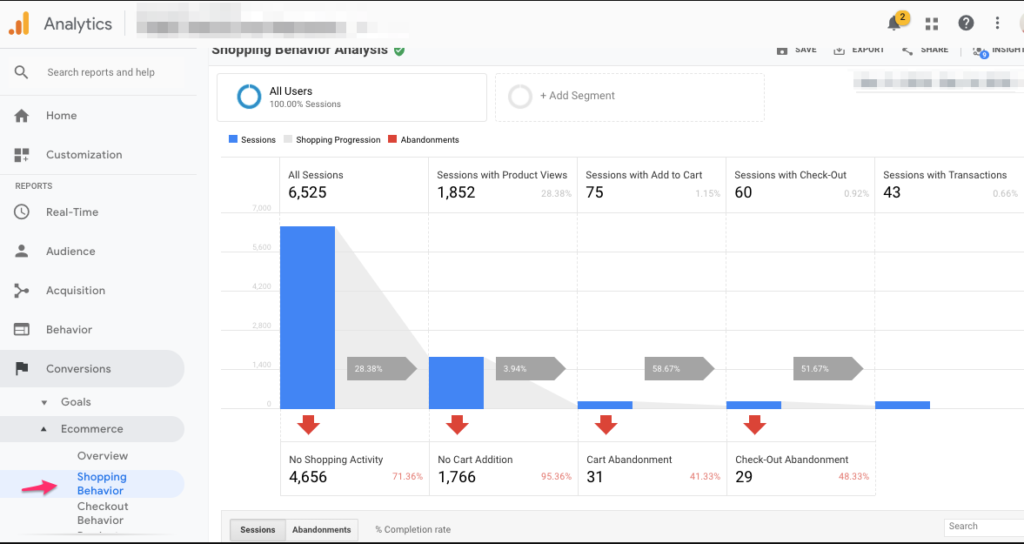
When it joins hands with ad campaigns, it tracks how people interact with those ads. It reveals which ads are bringing in the most visitors and which ones lead to sales, and it helps figure out if the money spent on those ads is worth it.
Google Analytics is like the backstage pass that shows exactly what’s happening with your marketing efforts, giving you the inside scoop to tweak your strategies and make them more effective.
What data insights can Google Analytics provide?
Google Analytics can give insights into a wide range of data that can help you improve your website and marketing performance. Here are some of the key areas where Google Analytics can provide valuable insights:
Website Traffic
Google Analytics can track how many visitors are coming to your website, where they are coming from, and what pages they are viewing. This information can help you understand your audience, identify your most popular pages, and track the effectiveness of your marketing campaigns.
Sales
Google Analytics can track your website’s sales data, including total revenue, average order value, and conversion rate. This information can help you identify areas for improvement in your sales process, track the effectiveness of your pricing strategies, and measure the impact of your marketing campaigns on sales.
Marketing Performance
Google Analytics can track the performance of your marketing campaigns, including your email marketing, social media marketing, product feed marketing, and paid advertising campaigns. This information can help you allocate your marketing resources more effectively, identify which campaigns are most effective, and measure the ROI of your marketing efforts.
User Experience
Google Analytics can track user engagement metrics, such as bounce rate, average session duration, and page depth. This information can help you understand how users are interacting with your website, identify areas for improvement in your website design and navigation, and improve the overall user experience.
Customer Acquisition
Google Analytics can track the customer acquisition process, including how visitors first discover your website and how they convert into customers. A customer acquisition marketing agency can help you analyze this information to identify your most effective acquisition channels, optimize your website for conversions, and improve your customer lifetime value.
In addition to these general insights, Google Analytics can also provide insights on specific areas of your business, such as:
eCommerce
Google Analytics can track eCommerce metrics, such as product adds to the cart, product removals from the cart, and checkout initiations. This information can help you identify areas for improvement in your checkout process, improve your product pages, and increase your conversion rate.
Content Marketing
Google Analytics can track content engagement metrics, such as page views, time on page, and social shares. This information can help you identify your most popular content, understand your audience’s interests, and improve your content marketing strategy.
Mobile Marketing
Google Analytics can track mobile website traffic, app usage, and mobile conversions. This can help you optimize your website for mobile users, identify opportunities for app development, and measure the effectiveness of your mobile marketing campaigns.
By tracking and analyzing these key data points, you can gain valuable insights into your website, customers, and marketing performance. This information can help you make informed decisions that will improve your website, increase your sales, and grow your business.
What is Google Analytics 4?
Google Analytics got a big upgrade called Google Analytics 4—it’s like the newer, cooler version that’s taken over from the old one called Universal Analytics.
Here’s the scoop: as of July 1, 2023, the old Universal Analytics stopped collecting new data. And by July 1, 2024, everyone using Universal Analytics won’t be able to access it anymore—everything’s shifting to Google Analytics 4.
To keep tracking how your website’s doing, you’ll need to switch over to Google Analytics 4. If you haven’t already made the move, it’s time to make the switch so you can keep an eye on your website’s performance!
If you’re new to Google Analytics, the platform will automatically assign GA4 to you by default. While you can still create a Universal Analytics property, it won’t serve any practical purpose.
Google Analytics 4 (GA4) is designed to provide a more comprehensive and future-proof understanding of user behavior across platforms and devices.
Therefore, it’s crucial to start using GA4 as soon as possible to ensure you have a continuous flow of data and can future-proof your analytics strategy. While UA data remains valuable for historical analysis, GA4 will be your key tool for understanding user behavior and optimizing your website and app going forward.
Although GA4 might require some initial adaptation compared to the familiar Universal Analytics, its advanced features and future-oriented approach make it a powerful tool for businesses of all sizes. If you haven’t already, we highly recommend exploring GA4 and its potential to unlock deeper insights and drive better results.
Here’s a breakdown of what makes GA4 unique:
Key features:
Event-based data
Unlike the session-based model of Universal Analytics, GA4 focuses on individual user actions (events) and their properties. This allows for more granular and flexible analysis, particularly in a cross-platform world.
Cross-platform tracking
GA4 seamlessly integrates data from websites and apps, providing a unified view of user journeys across different touchpoints. This is crucial for businesses with a multi-channel presence.
Predictive insights
Google Analytics WooCommerce GA4 uses machine learning to generate valuable predictions about future user behavior. This can help you anticipate trends, personalize experiences, and optimize marketing efforts.
Privacy-focused design
Built with privacy in mind, GA4 offers flexible data controls and anonymization features to comply with evolving regulations and user expectations.
Integration with other Google products
GA4 seamlessly connects with other Google products like Google Ads and Search Console, enabling powerful data analysis and campaign optimization.
How to connect WooCommerce to Google Analytics
In a series of steps, we will explain Google Analytics 4 WooCommerce integration in the following sections. We must mention that you can log in to Google Analytics using Gmail; it doesn’t require any separate registration process.
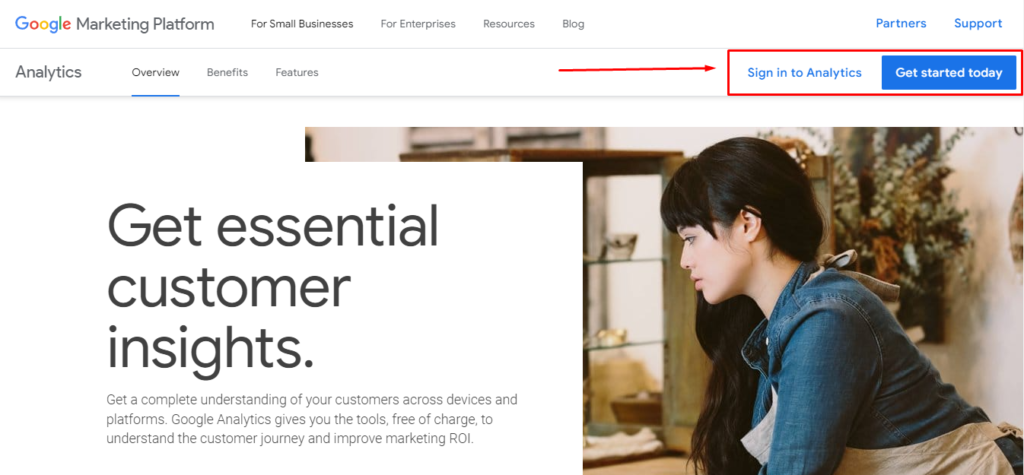
Google Analytics WooCommerce plugin installation
Google Analytics WooCommerce has its dedicated plugin in the WordPress plugin repository. To install the Google Analytics 4 WooCommerce plugin, go to Plugins >>Add New plugin.
While the following two plugins are the most popular Google Analytics plugins, they are for all types of websites. We want to install the Google Analytics WooCommerce developed by Woo official WooCommerce developers.
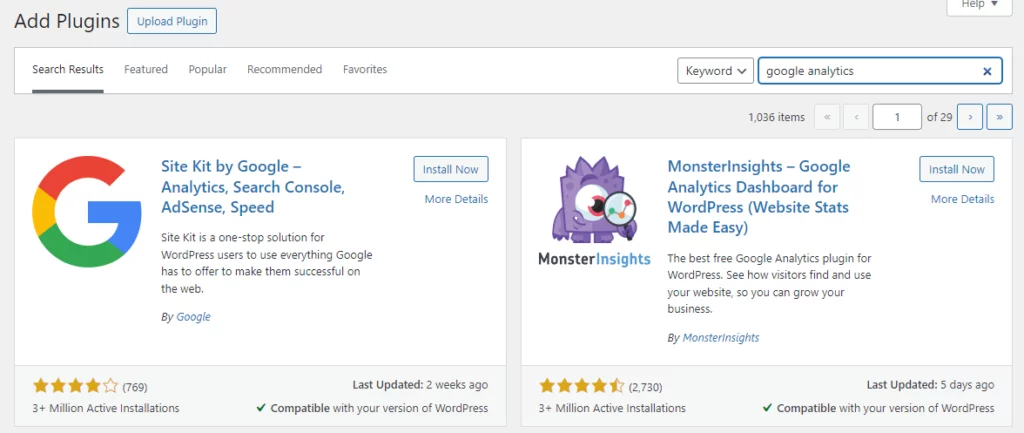
Scroll down to find the Google Analytics for WooCommerce plugin.
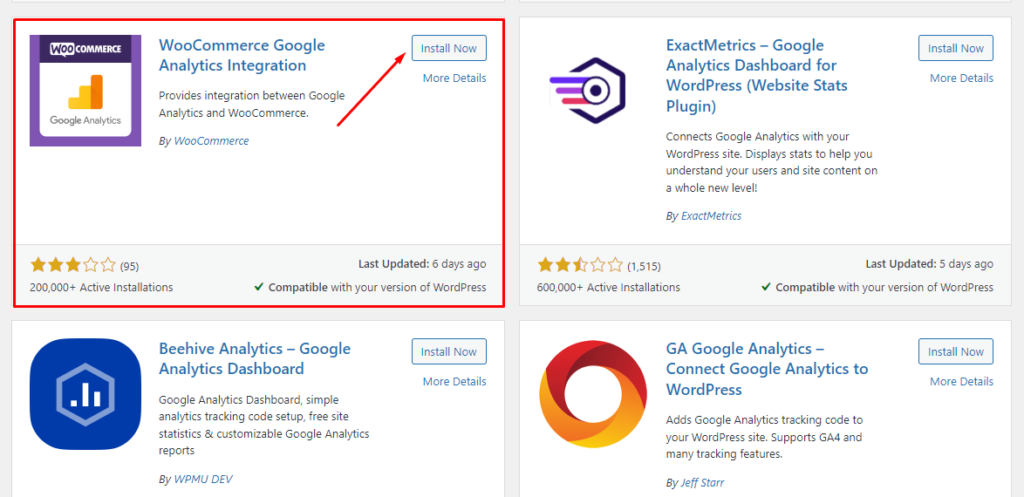
After you install and activate the WooCommerce Google Analytics 4 plugin, go to plugin settings or jump to WooCommerce>>Settings>>integration.
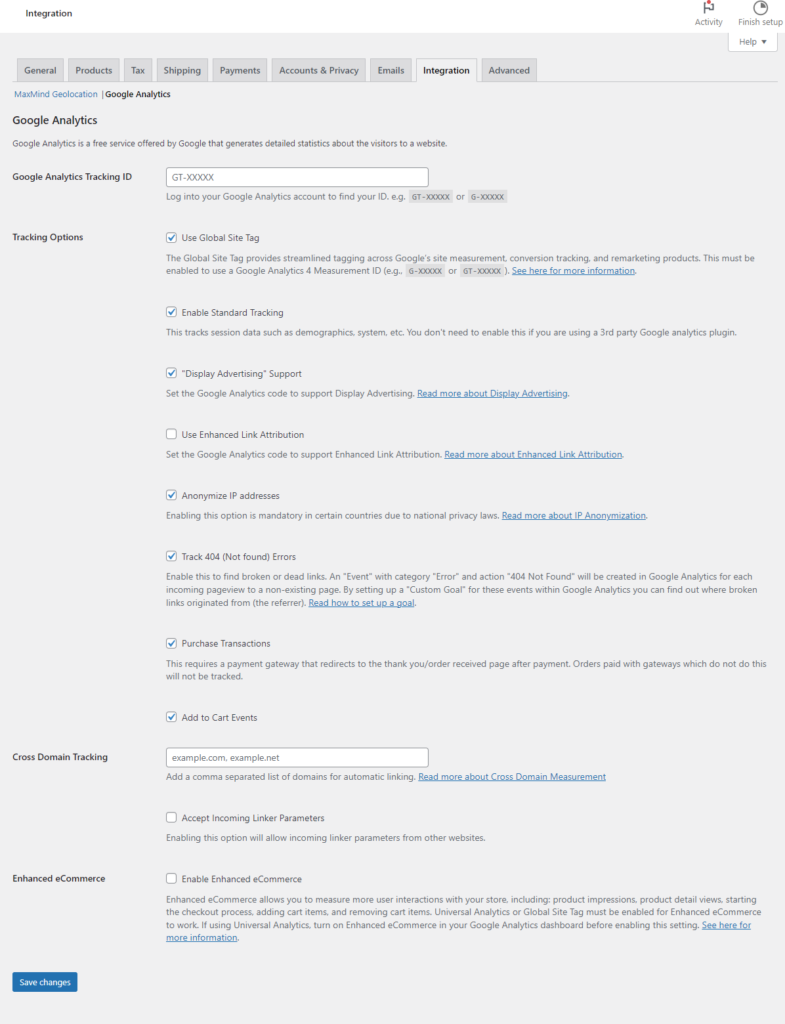
You will find the initial Google Analytics WooCommerce setup options here. To add Google Analytics to WooCommerce, you first need to collect the Google Analytics Tracking ID from the platform.
Collecting tracking ID for Google Analytics WooCommerce
Go to the official Google Analytics website and log in with your Gmail address.
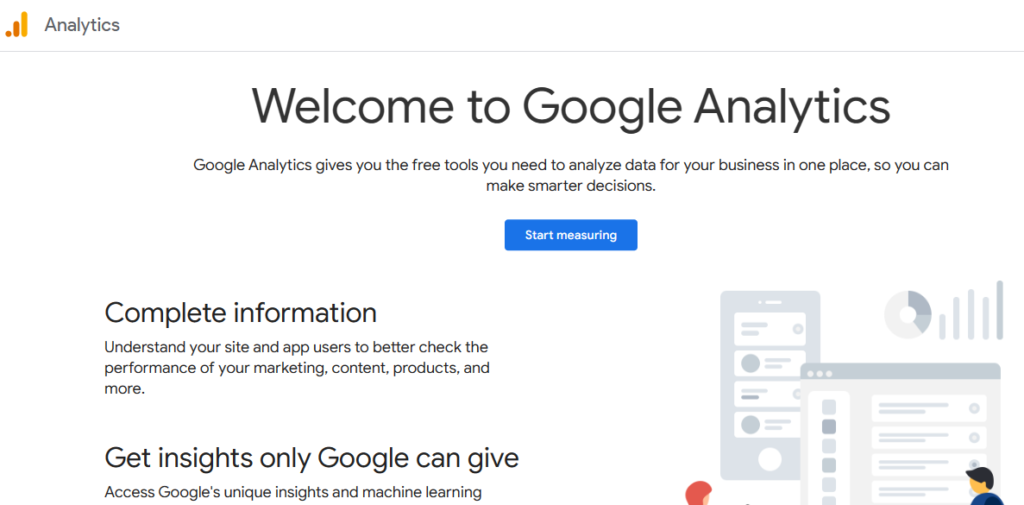
Here’s how the dashboard may appear.
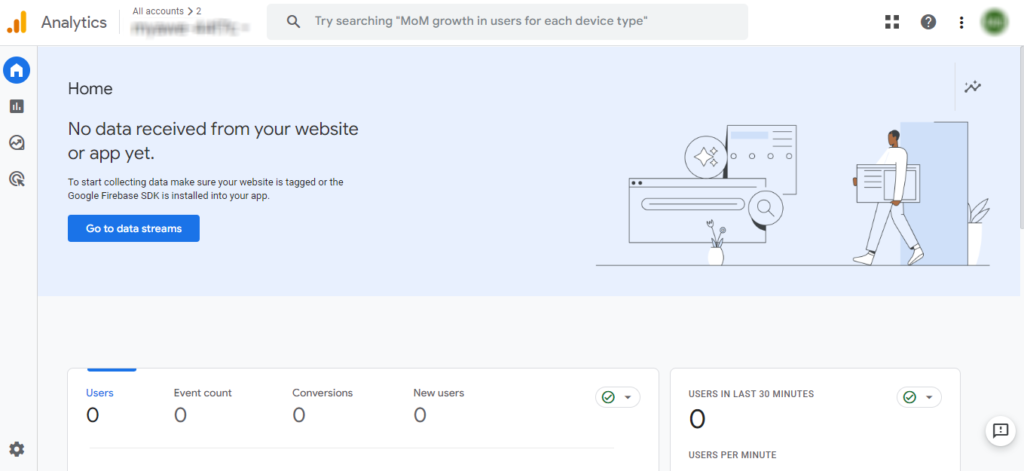
Move your mouse to the bottom and click on the Admin option.
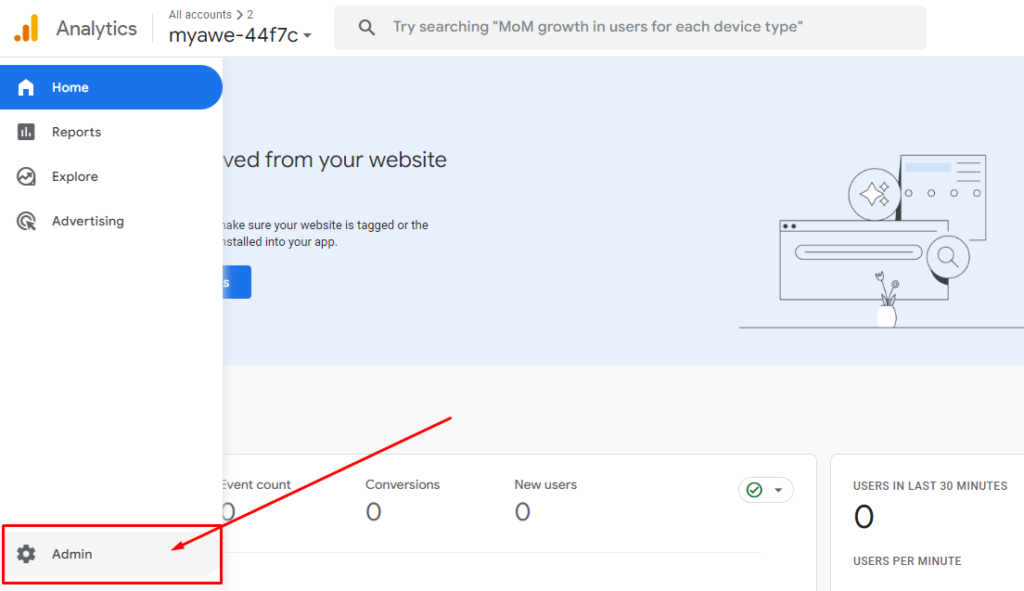
From the following window, click on Create and then Account to start the Google Analytics WooCommerce account creation process.

This will lead you to the account generation window. First, give your account a name and select your preferred data-sharing settings.
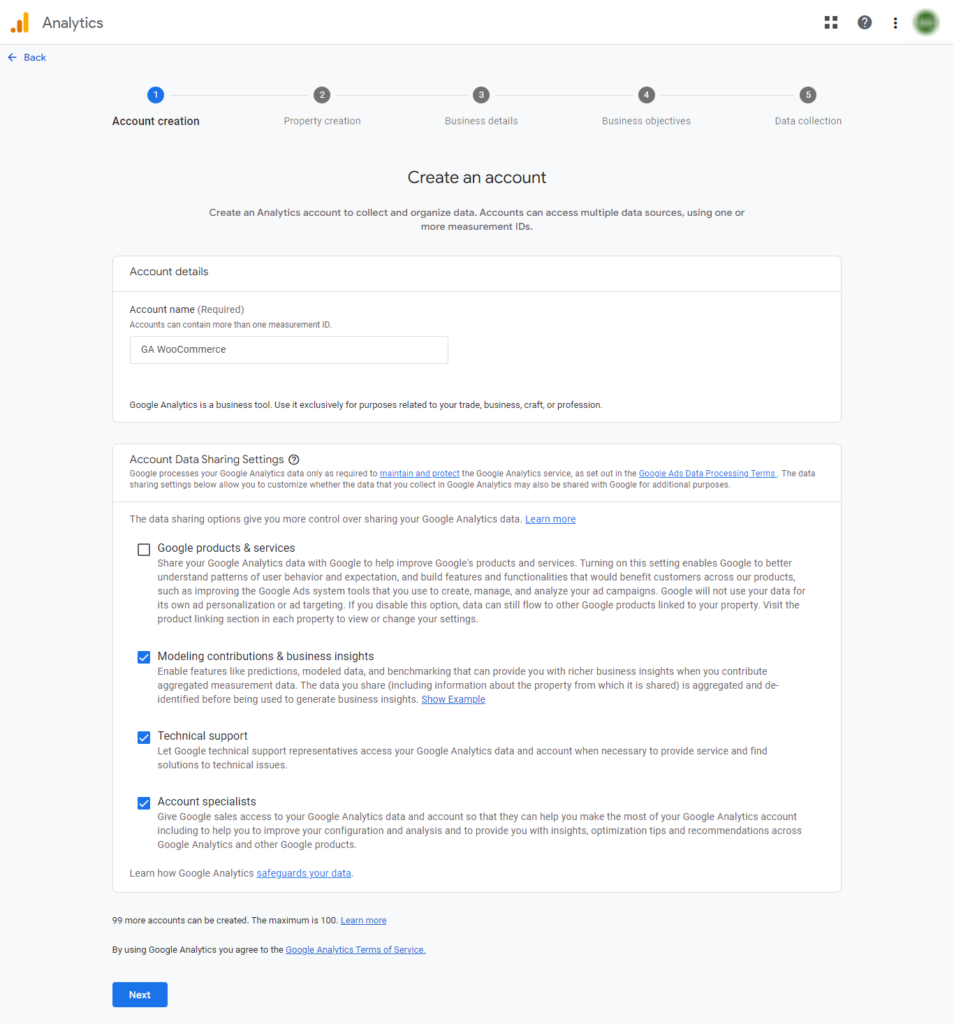
Next, you need to create a property. Think of a Google Analytics property as a special container that holds all the important data about how your websites or apps are doing. When you create one, it gathers and keeps track of everything—like how many people visit your sites or use your apps, what they do there, where they’re from, and much more.
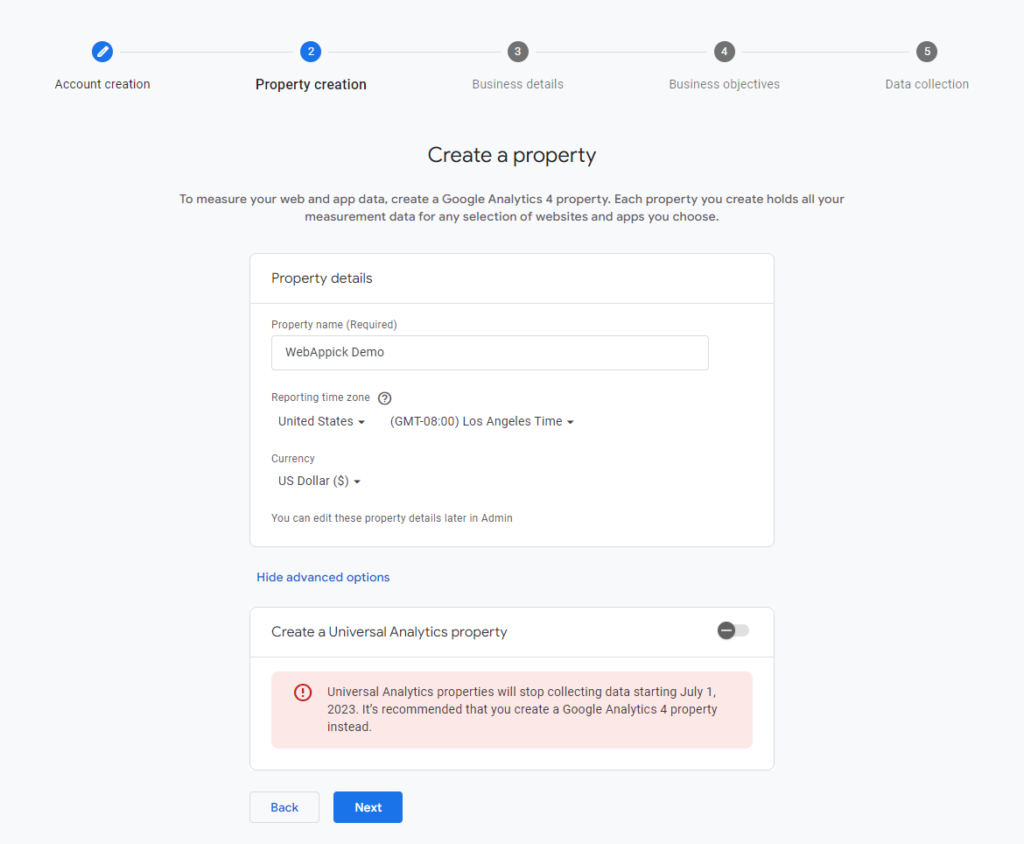
It’s like having a neat folder for each of your websites or apps where you can find all the details about how they’re performing. This helps you understand your audience better and make smart decisions to improve your online stuff.
On the next screen, select your industry category and business size.
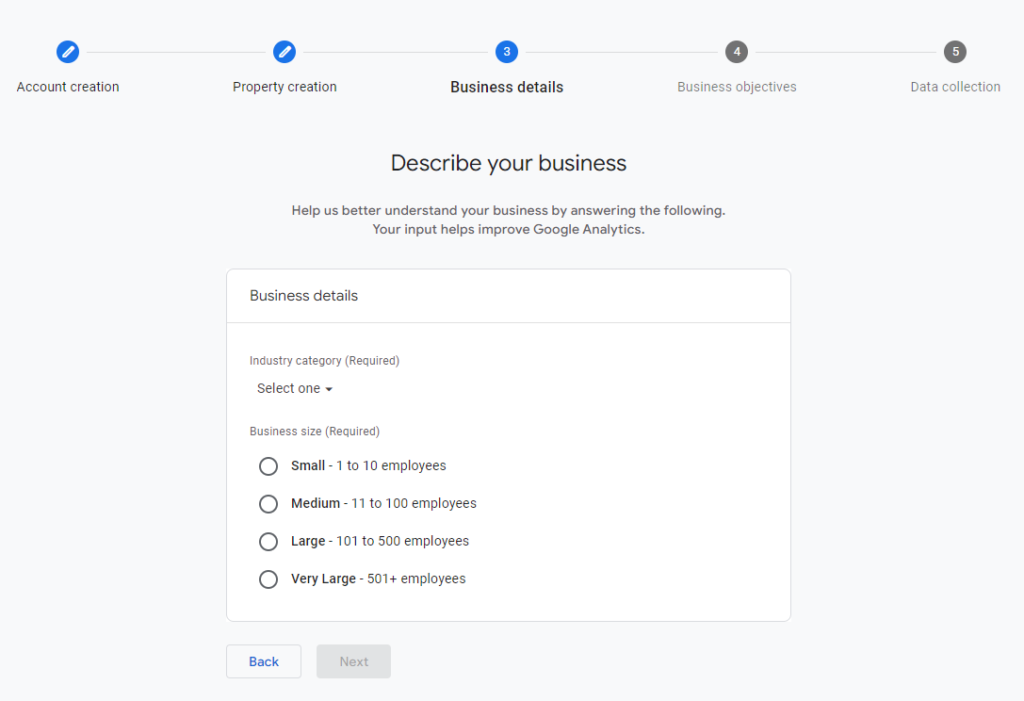
After that, select your business goals for your WooCommerce store.
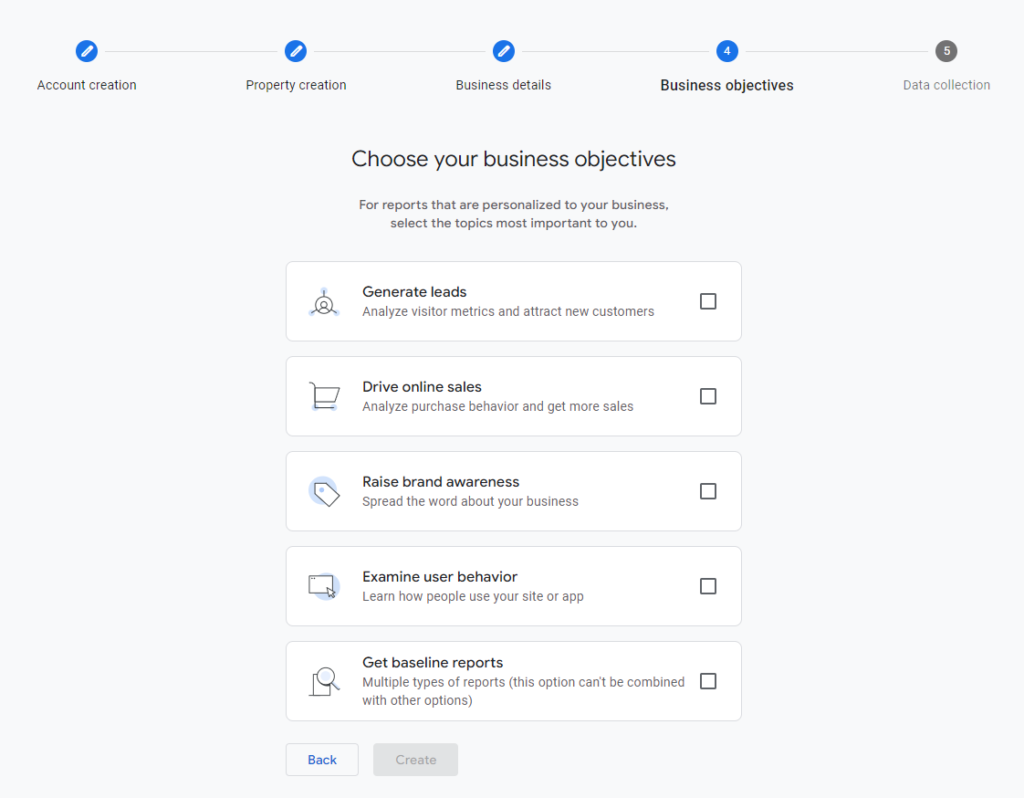
Once you select your goals, click Create and agree to terms.
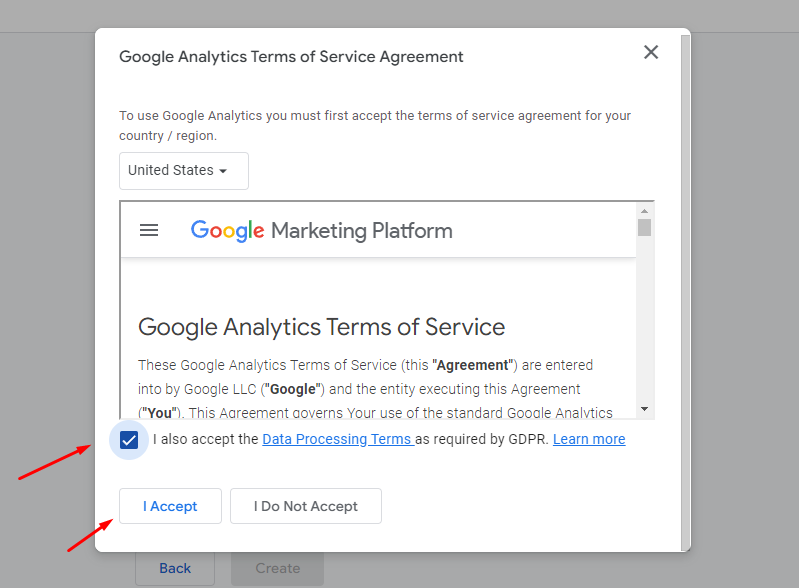
To set up Google Analytics WooCommerce and collect data for your website, you need to connect Google Analytics and WooCommerce. Select web from the following window.
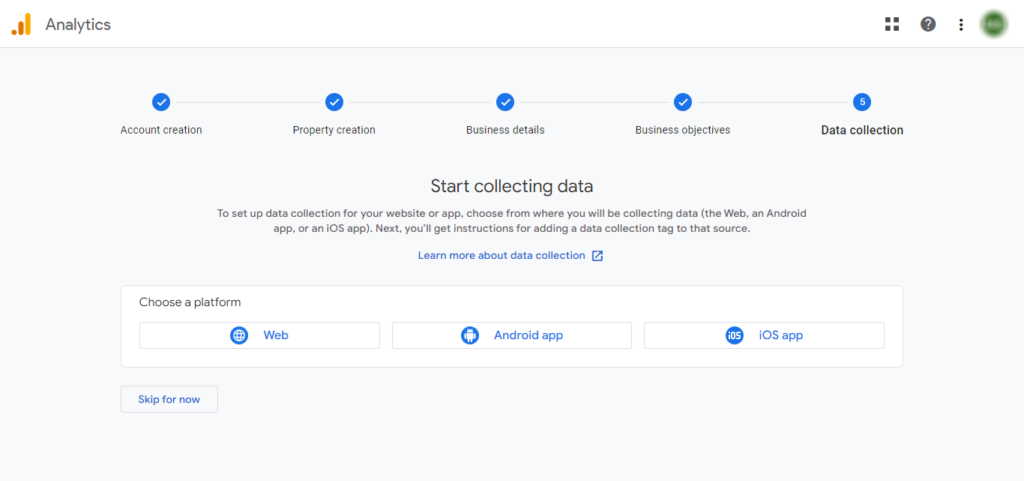
Input your WooCommerce website URL and click Create Stream.
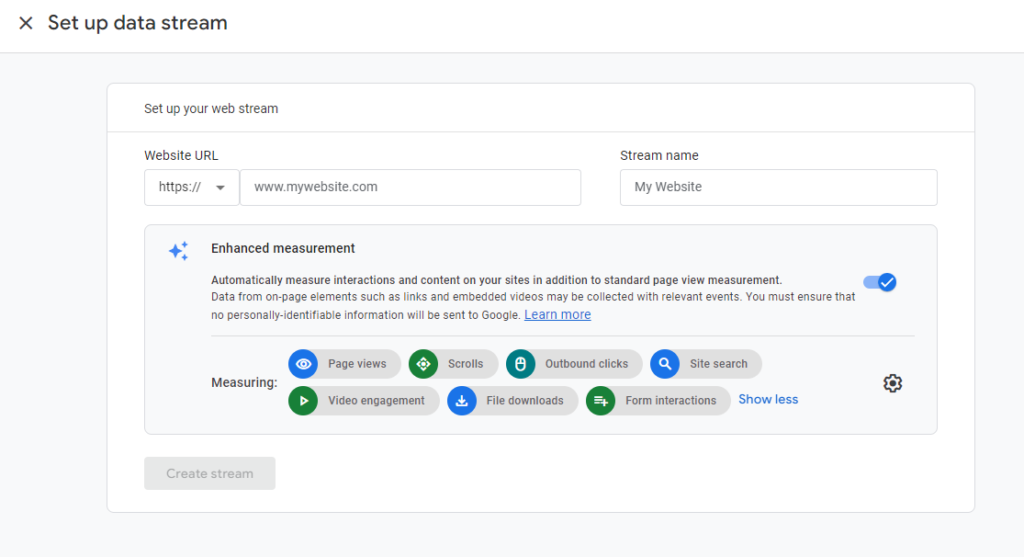
The following window holds what we came here for in the first place. Copy the Tag ID from this screen. This is the tracking ID you need to insert in the plugin settings.
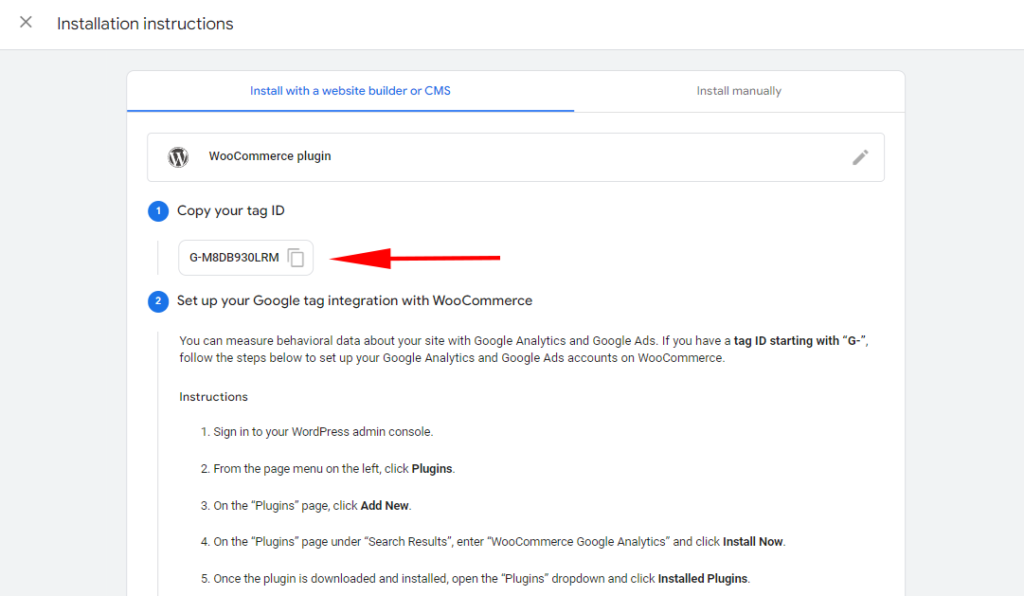
Connecting Google Analytics WooCommerce with tracking code
Again, jump to WooCommerce>>Settings>> Integration and paste the Tag ID into the Google Analytics Tracking ID field.
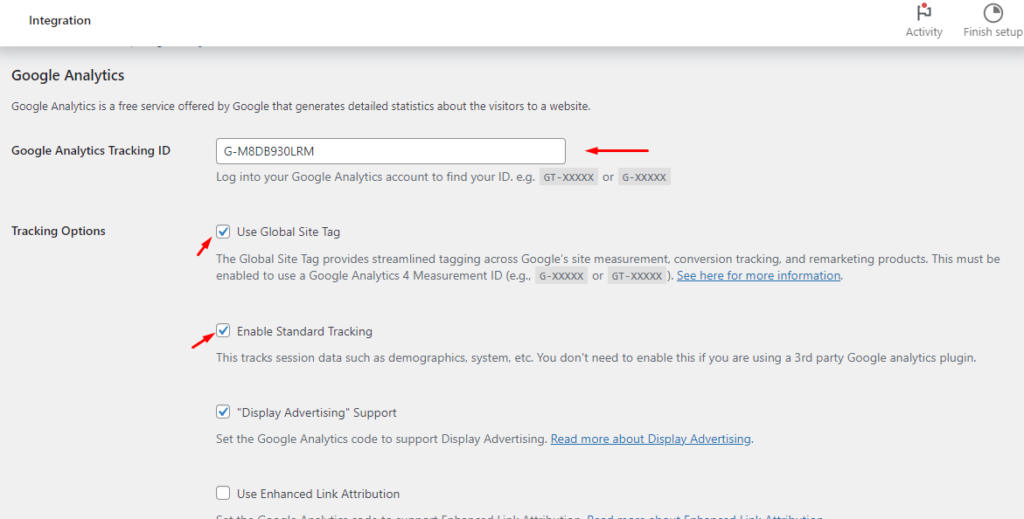
Make sure you checkmark Use Global Site Tag and Enable Standard Tracking options. This way, you won’t have to individually set up GA for various analytics behaviors like blog visits, search traffic, or other user actions across your site.
Google Analytics will take 24 hours to start tracking and displaying activity results.
Google Analytics and WooCommerce tracking for product feed marketing
If you aren’t aware of product feed marketing yet, then you are missing out on a world of opportunities. Through product feed marketing, you can simultaneously display, promote, and sell your products across the web alongside your WooCommerce website.
In product feed marketing, you can export your Woo products on a product feed file and upload it to hundreds of channels. A product feed file is most commonly a spreadsheet file that contains all your product data under characteristics like product prices, IDs, titles, descriptions, categories, etc.
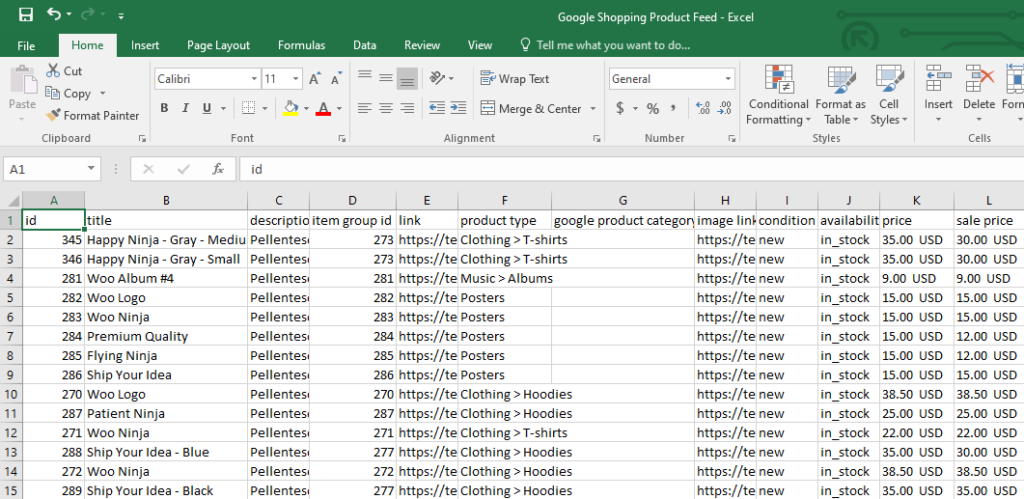
In a product feed, these characteristics are called attributes. You can display and sell your products on marketplaces like Amazon, Target, eBay, Walmart, etc.
You can list your products on affiliate sites and price comparison engines such as Google Shopping, Bing Shopping, Yahoo Shopping, etc. Social media sites like Facebook, Instagram, Snapchat, etc., also prefer product promotion through product feed files.
Most importantly, you must have WooCommerce product feed files to run product ads on Google, Bing, and other social media engines. Overall, if you play it right, you can reach millions of potential customers and increase your conversions by a considerable margin.
By playing it right, we mean managing your product feed marketing campaigns efficiently. You need to use a product feed management tool that can automate almost the entire process and help you track your campaign performance through Google Analytics WooCommerce.
And the best product feed plugin for the job is CTX Feed.
Tracking product feed campaign performance using CTX Feed
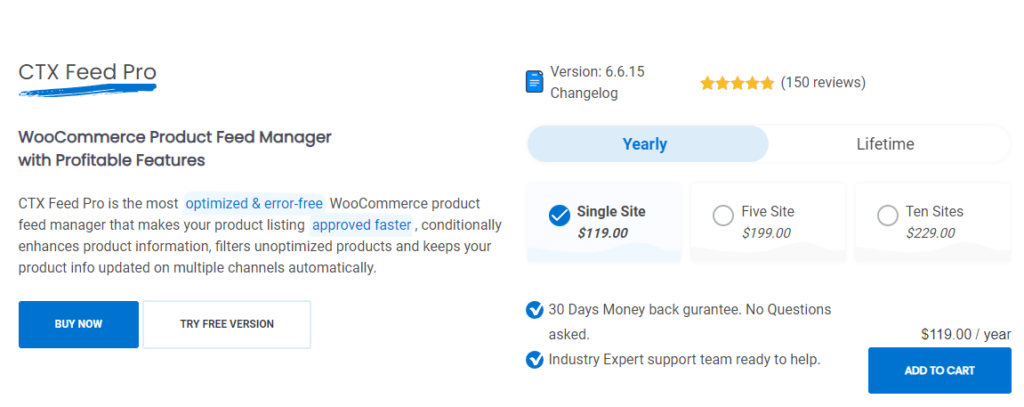
CTX Feed makes it super easy to create a feed file. You don’t need any skill to generate a feed with this plugin.
It supports over 130 channels and has built-in templates for them. Every channel that supports product feed marketing has its own guidelines and a list of attributes you need to include in your feed files.
CTX Feed integrated those guidelines and attributes in its templates. You only need to select the template, and the plugin will generate all attributes and collect your product data for them.
Simply select a template and click the generate button. Voila! Your feed file will be ready to upload.
Promoting and managing products on multiple platforms would be a daunting task. Especially when you make regular changes to your product information and run different types of sale/discount campaigns.
CTX Feed is a fantastic tool to automate product management across all your channels. It has automatic update and feed URL connection features.
Through these features, you only need to connect to a channel once, and the plugin and channel will take it from there and always display accurate information.
And to track the performances of your product feed marketing campaigns on different channels, CTX Feed lets you add Google Analytics UTM parameters to your product URLs. This helps you figure out how well your marketing channels are doing by using Google Analytics.
Let’s discuss UTM parameters and how to track your feed campaign in detail.

What are UTM parameters, and how to add Google Analytics WooCommerce UTM parameters to the product URL?
Let’s say you are promoting a specific product on various channels. You are running ads on Google, created posts on Facebook, Instagram, Snapchat about the product, etc.
You are getting a good amount of visitors/traffic and sales on the product. How do you know which channel is bringing the most traffic and sales?
That’s where UTM parameters come into play. In simple words, UTM campaign parameters are used to create custom URLs to track the performance of a campaign, promotion, post, link, etc. It helps Google Analytics track and report the performance of your marketing campaigns.
As a result, you can make data-driven decisions. For example, for the above example product promotion, you can track which channel is earning the most visitors and revenues and which channel doesn’t have any impact.
You can then focus more on the channel that yields more profits for you. It’s all about focusing on what works best to boost your success!
Let’s take a look at how you can add a URL parameter to your product URLs using CTX Feed. For example, let’s say you are creating a Google Shopping feed.
You can learn the complete process of WooCommerce Google Shopping integration from this article. We will quickly create a test feed.
After you install the plugin, you can click on the following menu to get started.
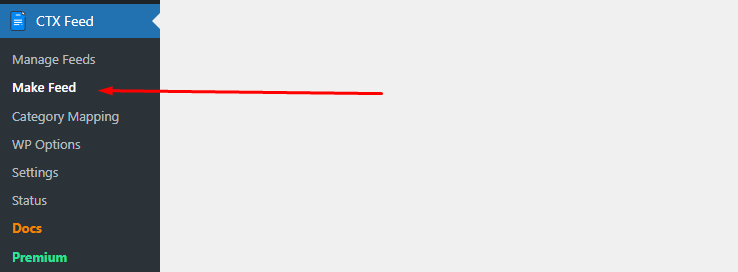
Select your channel template.

And as we said, CTX Feed will automatically populate the needed attributes.
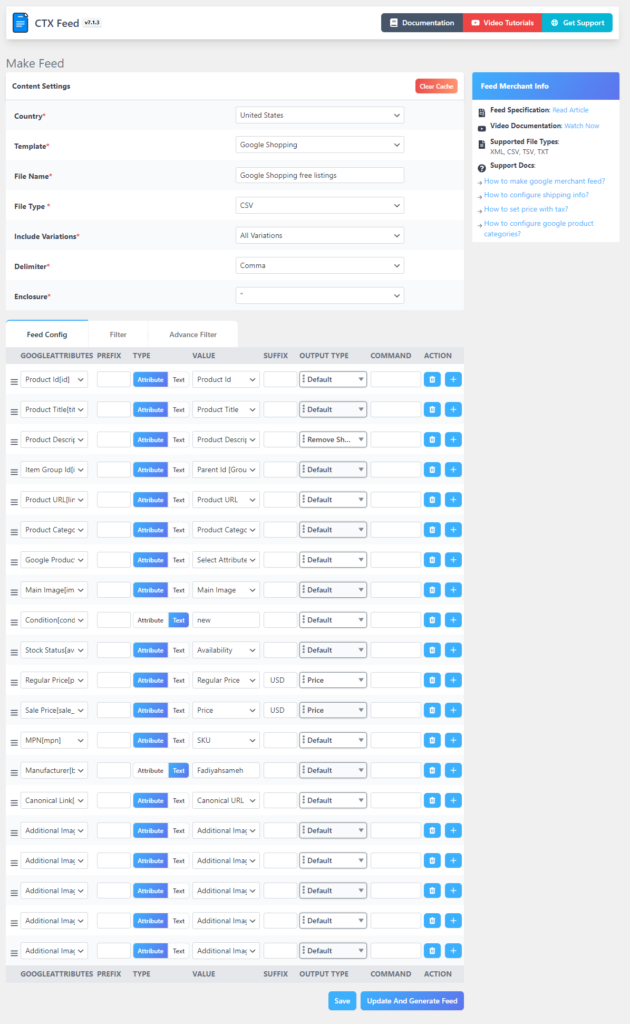
Jump to the Filters tab and scroll down to find the Campaign URL Builder section. You can set the parameters from here and generate the feed file when done.
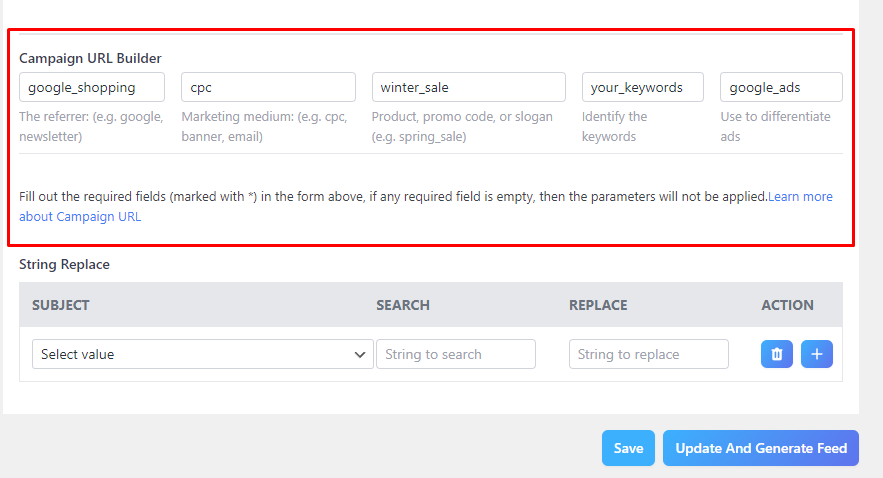
This will assign custom parameters to all of your product links, and Google Analytics WooCommerce will be able to track them all and report which products are most popular and which ads are performing the best.
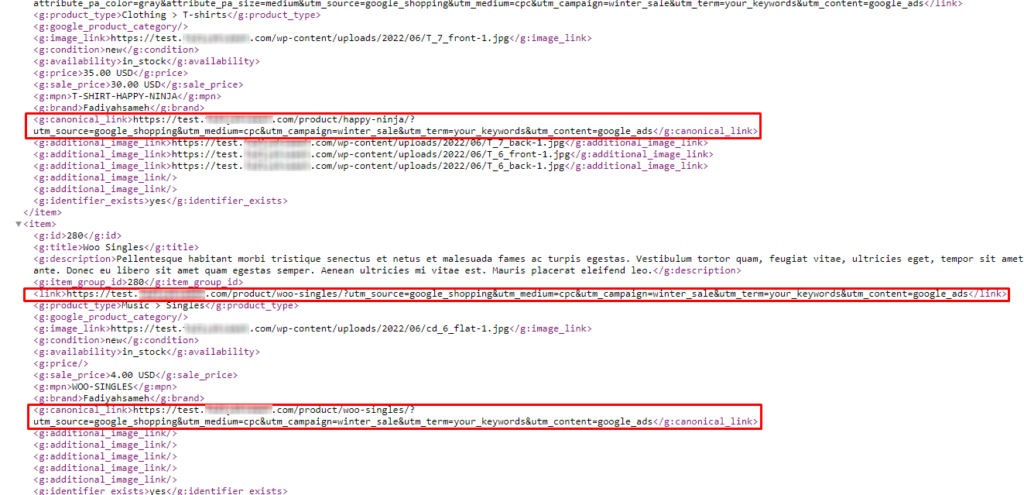
What are the parameters for Google Analytics WooCommerce?
Think of UTM parameters like labels you add to the links you share. These labels help Google Analytics understand where your website visitors come from and what they do on your site.
There are five types of labels you can use:
1. **utm_source**: This tells you where your visitors are coming from, like Google, a newsletter, or a specific website.
2. **utm_medium**: This describes the type of marketing, like a banner ad, email, or cost-per-click (CPC) campaign.
3. **utm_campaign**: It’s like a name tag for your campaign—think “Summer Sale” or “Holiday Promo.”
4. **utm_term**: If you’re running ads with specific keywords, this helps you track which keyword brought someone to your site.
5. **utm_content**: This one’s for telling apart similar things, like different links in the same email. For instance, you might use it to see which button in an email gets more clicks.
Each label needs a value that you assign. For instance, if you’re running a Summer Sale email campaign, your link might look like this:
https://www.example.com/?utm_source=summer-mailer&utm_medium=email&utm_campaign=summer-sale
Adding these labels helps you see which campaigns or sources are bringing in the most visitors and sales so you can focus on what works best. Remember, the first three (utm_source, utm_medium, and utm_campaign) are a must, but the other two are optional.
Benefits of Google Analytics WooCommerce
Here’s why Google Analytics WooCommerce is your secret weapon for WooCommerce success:
Deep customer understanding
- Know who your customers are: Uncover their demographics, location, interests, and online behavior. Are they mobile shoppers? Desktop browsers? Understanding your audience allows you to tailor your marketing and product offerings accordingly.
- See what they do on your store: Track their journey from product page to checkout, identifying bottlenecks and areas for improvement. Are they abandoning carts? Struggling to find what they need? Fix the roadblocks and watch conversions soar.
- Segment them like a pro: Group customers based on purchase history, browsing behavior, or any other criteria. This lets you create targeted marketing campaigns and personalize their experience for maximum impact.
Sales & performance insights
- Track every penny: See which products are bestsellers, which promotions are driving revenue, and where your marketing dollars are generating the best return on investment (ROI). No more guessing what works and what doesn’t!
- Identify conversion killers: Are visitors adding items to their cart but never checking out? Analyze the checkout process for friction points and streamline it for smoother conversions.
- Benchmark yourself against the best: See how your store stacks up against industry averages and competitors. Are you lagging behind? Use this data to identify areas where you can leapfrog ahead.
Data-driven marketing decisions
- Craft laser-focused campaigns: Target your ads, emails, and social media posts to specific customer segments based on their interests, purchase history, and online behavior. This translates to higher engagement and better conversion rates.
- Personalize the shopping experience: Recommend products they’re likely to love, show them relevant content, and offer them personalized discounts. This makes them feel valued and increases their loyalty to your brand.
- Predict future trends: Analyze historical data and customer behavior to anticipate future demand and optimize your inventory accordingly. No more getting caught off guard by surprise sales spikes!
It’s Free (and easy to use!)
Yes, you read that right. Google Analytics WooCommerce is completely free to use, even for WooCommerce stores. And with its intuitive interface and helpful tutorials, getting started is a breeze. No coding required!
Future-proof your business
Google Analytics is constantly evolving, adding new features and integrations to stay ahead of the curve. This means you’ll always have the latest tools and insights to navigate the ever-changing eCommerce landscape.
Frequently Asked Questions
WooCommerce developers have developed a dedicated plugin to integrate Google Analytics into the WooCommerce site. You can install the plugin and copy-paste your GA tag ID to enable Google Analytics tracking for your Woo store.
You need to log in and create a new account and a new property on Google Analytics. After you complete all the steps, the platform will give you a tag ID. You can add this code to WooCommerce manually or through a plugin.
Wrap up
Remember, Google Analytics WooCommerce is a journey, not a destination. Keep learning, experiment with different features, and track your progress. With each step you take, you’ll gain a deeper understanding of your customers, optimize your store for success, and watch your WooCommerce business reach new heights.
